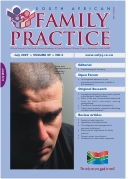Female urinary incontinence: A review
Keywords:
urinary in continence, stress incontinence, overactive bladder, colposuspension, anticholinergic drugs
Abstract
Urinary incontinence affects approximately a quarter of a billion people worldwide. It is associated with high economic costs, psychological morbidity and adverse effects on the quality of life. Despite this, few women seek help for this condition either due to embarrassment and unwillingness to discuss the symptom with their family member or friend or, acceptance of the disorder as a natural part of aging or being unaware that treatment exists. More resources are utilised in maintaining patients with chronic incontinence rather than for diagnosis and treatment of the condition. Urinary incontinence is a complex problem resulting from many different causes and for which many different approaches to treatment exist. The commonest types of incontinence include stress urinary incontinence, urge urinary incontinence and mixed incontinence. Recently, better understanding of the pathophysiology of urinary incontinence has led to the development of numerous non-pharmacological, pharmacological and surgical interventions.
Issue
Section
CPD
By submitting manuscripts to SAFP, authors of original articles are assigning copyright to the South African Academy of Family Physicians. Copyright of review articles are assigned to the Publisher, Medpharm Publications (Pty) Ltd, unless otherwise specified. Authors may use their own work after publication without written permission, provided they acknowledge the original source. Individuals and academic institutions may freely copy and distribute articles published in SAFP for educational and research purposes without obtaining permission.

